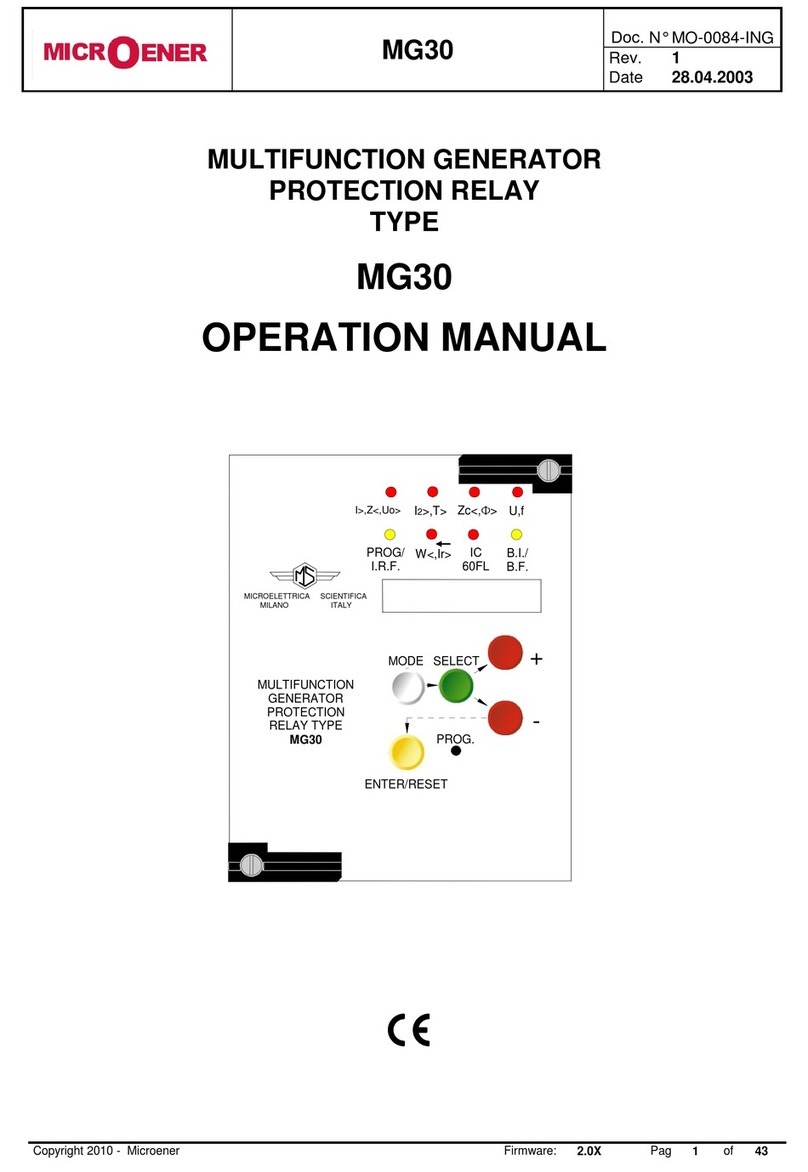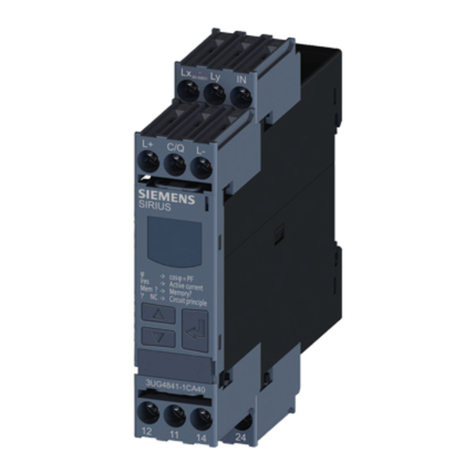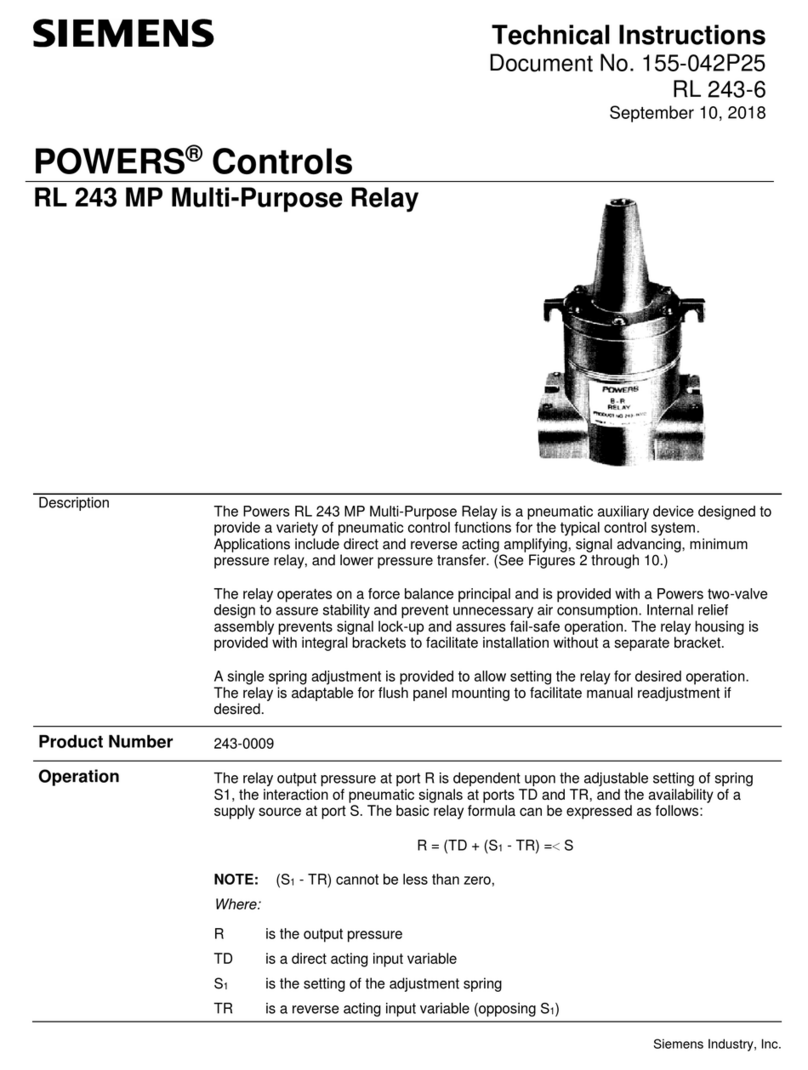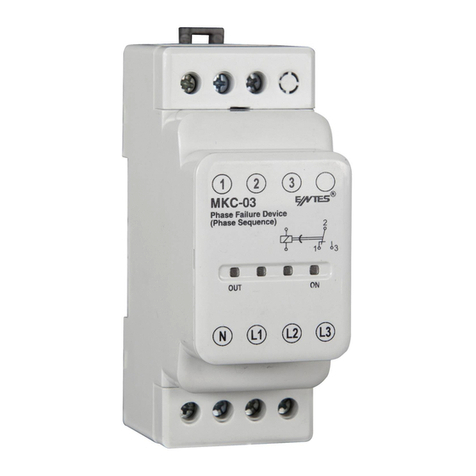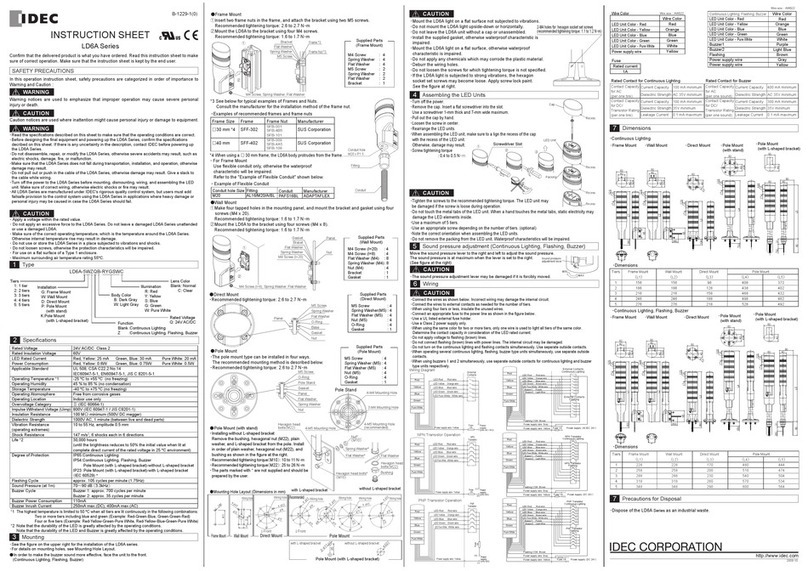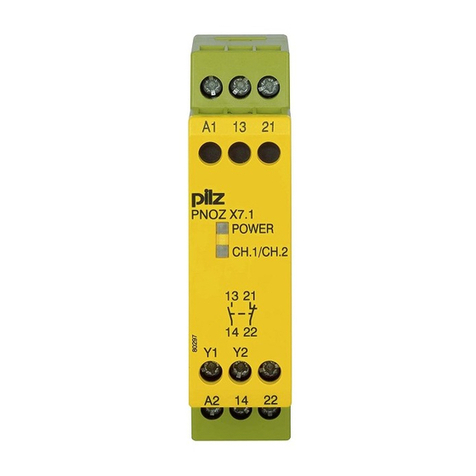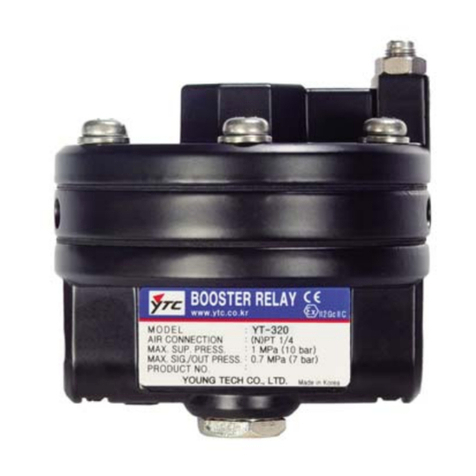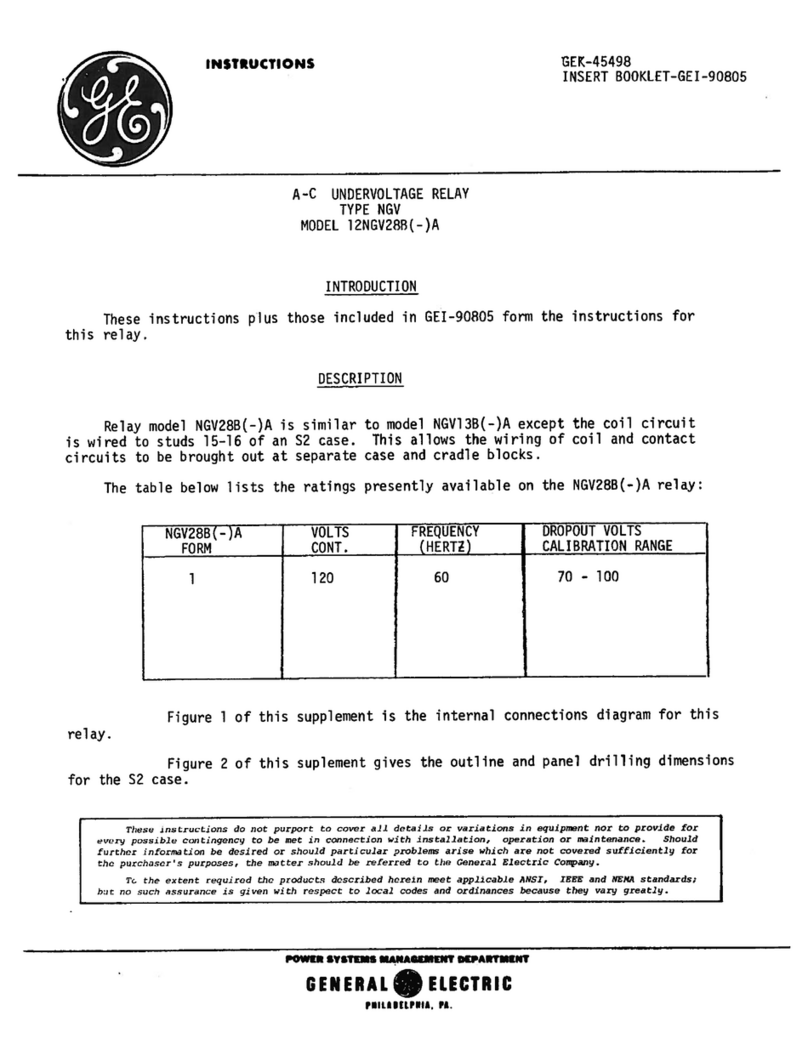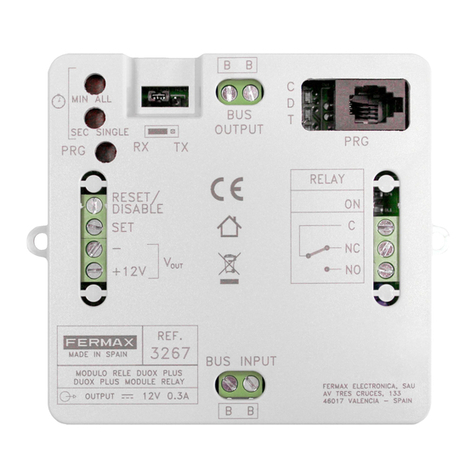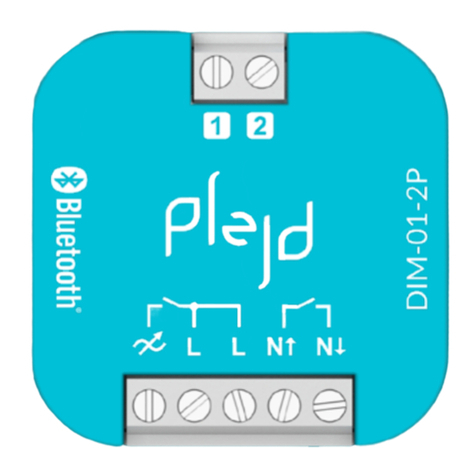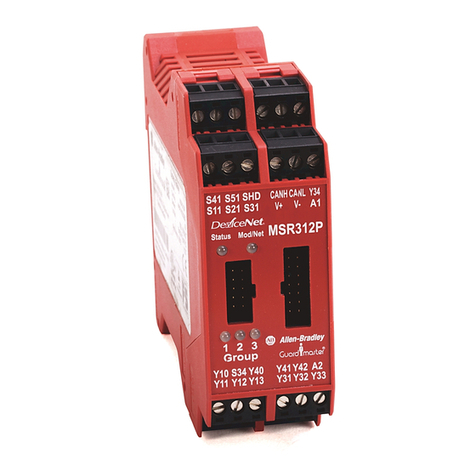MICROENER MM30-W User manual

MM30-W
Doc. N° MO-0117-ING
Rev. 1
Pag. 1 of 29
Copyright - 2010 - Microener
MICROPROCESSOR
MOTOR PROTECTION RELAY
TYPE
MM30-W
OPERATION MANUAL
MULTIFUNCTION
MOTOR PROTECTION
RELAY TYPE
MM30-W
ENTER/RESET
MODE
SELECT
+
-
PROG.
St.N°
I>,O>
PROG/
I.R.F.
MICROELETTRICA SCIENTIFICA
MILANO ITALY
T>
I2>,1
U,f,
I<
ROTOR
STALL

MM30-W
Doc. N° MO-0117-ING
Rev. 1
Pag. 2 of 29
Copyright - 2010 - Microener
INDEX
1 General utilization and commissioning directions __________________________________________3
1.1 Storage and transportation__________________________________________________________ 3
1.2 Installation_______________________________________________________________________ 3
1.3 Electrical connection_______________________________________________________________ 3
1.4 Measuring inputs and power supply___________________________________________________ 3
1.5 Outputs loading___________________________________________________________________ 3
1.6 Protection earthing_________________________________________________________________3
1.7 Setting and calibration______________________________________________________________ 3
1.8 Safety protection__________________________________________________________________ 3
1.9 Handling_________________________________________________________________________3
1.10 Maintenance_____________________________________________________________________ 4
1.11 Fault detection and repair___________________________________________________________ 4
2 General characteristics and operation____________________________________________________ 4
2.1 Power supply_____________________________________________________________________ 4
2.2 Clock and Calendar________________________________________________________________ 5
2.2.1 Clock synchronization__________________________________________________________ 5
2.2.2 Date and time setting__________________________________________________________ 5
2.2.3 Time resolution_______________________________________________________________ 5
2.2.4 Operation during power off______________________________________________________ 5
2.2.5 Time tolerance_______________________________________________________________ 5
3 Controls and measurements____________________________________________________________ 6
4 Signalization_________________________________________________________________________ 7
5 Output relays_________________________________________________________________________8
6 Serial communication__________________________________________________________________9
7 Digital inputs_________________________________________________________________________10
8 Test________________________________________________________________________________ 10
9 Keyboard and display operation_________________________________________________________ 11
10 Reading of measurements and recorded parameters________________________________________12
10.1 ACT. MEAS (Actual measure)___________________________________________________12
10.2 MAX VAL (Max values)_______________________________________________________12
10.3 LASTTRIP (Last trip)_________________________________________________________ 13
10.4 TRIP NUM (Trip number)______________________________________________________ 13
11 Reading of programmed settings and relay’s configuration__________________________________ 13
12 Programming_________________________________________________________________________14
12.1 Programming of functions settings________________________________________________ 14
12.2 Programming the configuration of output relay_______________________________________ 16
13 Manual and automatic test operation_____________________________________________________ 17
13.1 Mode “ TESTPROG “ subprogram “ W/O TRIP “_____________________________________ 17
13.2 Mode “ TESTPROG “ subprogram “ With TRIP “_____________________________________ 17
14 Maintenance_________________________________________________________________________ 17
15 Power frequency insulation test_________________________________________________________ 17
16 Electrical characteristics_______________________________________________________________ 18
17 Connection diagram (Standard Output)____________________________________________________ 19
17.1 Connection Diagram (Double Output)_________________________________________________19
18 Wiring the serial communication bus_____________________________________________________20
19 Change phase rated input 1A or 5A______________________________________________________ 20
20 Thermal image curves_________________________________________________________________ 21
21 Inverse time unbalance protection element________________________________________________22
22 Direction for pcb’s draw-out and plug-in__________________________________________________ 23
22.1 Draw-out____________________________________________________________________ 23
22.2 Plug-in______________________________________________________________________23
23 Overall dimensions / Mounting__________________________________________________________ 24
24 Keyboard operational diagram__________________________________________________________ 25
25 Setting’s form________________________________________________________________________ 26

MM30-W
Doc. N° MO-0117-ING
Rev. 1
Pag. 3 of 29
Copyright - 2010 - Microener
1. General utilization and commissioning directions
Always make reference to the specific description of the product and to the
Manufacturer's instruction.
Carefully observe the following warnings.
1.1 STORAGE AND TRANSPORTATION,
must comply with the environmental conditions stated on the product's instruction or by the
applicable IEC standards.
1.2 INSTALLATION,
must be properly made and in compliance with the operational ambient conditions stated by
the Manufacturer.
1.3 ELECTRICAL CONNECTION,
must be made strictly according to the wiring diagram supplied with the Product, to its electrical
characteristics and in compliance with the applicable standards particularly with reference to
human safety.
1.4 MEASURING INPUTS AND POWER SUPPLY,
carefully check that the value of input quantities and power supply voltage are proper and within
the permissible variation limits.
1.5 OUTPUTS LOADING,
must be compatible with their declared performance.
1.6 PROTECTION EARTHING
When earthing is required, carefully check its effectiveness.
1.7 SETTING AND CALIBRATION
Carefully check the proper setting of the different functions according to the configuration of the
protected system, the safety regulations and the co-ordination with other equipment.
1.8 SAFETY PROTECTION
Carefully check that all safety means are correctly mounted, apply proper seals where
required and periodically check their integrity.
1.9 HANDLING
Notwithstanding the highest practicable protection means used in designing M.S. electronic
circuits, the electronic components and semiconductor devices mounted on the modules can be
seriously damaged by electrostatic voltage discharge which can be experienced when handling
the modules.
The damage caused by electrostatic discharge may not be immediately apparent but the design
reliability and the long life of the product will have been reduced. The electronic circuits reduced
by M.S. are completely safe from electrostatic discharge (8 KV IEC 255.22.2) when housed in
their case; withdrawing the modules without proper cautions expose them to the risk of damage.

MM30-W
Doc. N° MO-0117-ING
Rev. 1
Pag. 4 of 29
Copyright - 2010 - Microener
a. Before removing a module, ensure that you are at the same electrostatic potential
as the equipment by touching the case.
b. Handle the module by its front-plate, frame, or edges of the printed circuit board.
Avoid touching the electronic components, printed circuit tracks or connectors.
c. Do not pass the module to any person without first ensuring that you are both at
the same electrostatic potential. Shaking hands achieves equipotential.
d. Place the module on an antistatic surface, or on a conducting surface which is at
the same potential as yourself.
e. Store or transport the module in a conductive bag.
More information on safe working procedures for all electronic equipment can be found
in BS5783 and IEC 147-OF.
1.10 - MAINTENANCE
Make reference to the instruction manual of the Manufacturer ;
maintenance must be carried-out by specially trained people and in strict conformity
with the safety regulations.
1.11 - FAULT DETECTION AND REPAIR
Internal calibrations and components should not be altered or replaced.
For repair please ask the Manufacturer or its authorised Dealers.
Misapplication of the above warnings and instruction relieves the Manufacturer of any liability.
2. GENERAL
Input currents are supplied to 3 current transformers: - two measuring phase current (the third current is
computed as vector sum of the two others) - one measuring the earth fault zero-sequence current.
Phase current rated input can be 1 or 5A (Selectable by movable bridges an relay card)
For zero-sequence current taps for 1A and 5A input are provided on relay's terminal board.
Phase-to-phase voltage input is supplied to one voltage transformer. Rated input voltage can be
adjusted from 100 to 125V –50 or 60Hz.
Make electric connection in conformity with the diagram reported on relay's enclosure.
Check that input currents are same as reported on the diagram and on the test certificate.
The auxiliary power is supplied by a built-in interchangeable module fully isolated an self protected.
2.1 POWER SUPPLY
The relay can be fitted with two different types of power supply module :
24V(-20%) / 110V(+15%) a.c. 80V(-20%) / 220V(+15%) a.c.
a) - b) -
24V(-20%) / 125V(+20%) d.c. 90V(-20%) / 250V(+20%) d.c.
Before energising the unit check that supply voltage is within the allowed limits.

MM30-W
Doc. N° MO-0117-ING
Rev. 1
Pag. 5 of 29
Copyright - 2010 - Microener
2.2 CLOCK AND CALENDAR
The unit features a built in clock calendar with Years, Months, Days, Hours, Minutes, Seconds,
Tenths of seconds and Hundredths of seconds.
2.2.1 Clock synchronization.
The clock can be synchronized via a digital input (terminals 1 –14) or the serial communication
interface. The following synchronization periods can be set: 5, 10, 15, 30, 60 minutes.
Synchronization can also be disabled, in which case the only way to modify the current date and
time is via the front panel keyboard (SETTINGS menu) or the serial communication interface.
In case synchronization is enabled, the unit expects to receive a sync signal at the beginning of
every hour and once every Tsyn minutes. When a sync signal is received, the clock is
automatically set to the nearest expected synchronization time.
For example: if Tsyn is 10min and a sync signal is received at 20:03:10 January the 10th, 98, then
the clock is set to 20:00:00 January the 10th, 1998.
On the other hand, if the same sync signal were received at 20:06:34, the clock would be set to
20:10:00, January the 10th 98.
Note that if a sync signal is received exactly in the middle of a Tsyn period, the clock is set to the
previous expected synchronization time.
2.2.2 Date and time setting.
When the PROG/SETTINGS menu is entered, the current date is displayed with one of the
groups of digits (YY, MMM or DD) blinking.
The DOWN key operates as a cursor. It moves through the groups of digits in the sequence
YY => MMM => DD => YY => …
The UP key allows the user to modify the currently blinking group of digits.
If the ENTER button is pressed the currently displayed date is captured.
On the other hand pressing the SELECT button leaves the current date unchanged and scrolls
the SETTINGS menu. Current time can now be modified using the same procedure described
above. If synchronization is enabled and the date (or time) is modified, the clock is stopped until
a sync signal is received (via digital input or the serial port). This allows the user to manually set
many units and have them to start their clocks in a synchronized fashion.
On the other hand if synchronization is disabled the clock is never stopped.
Note that the setting of a new time always clears 10ths and 100ths of sec.
2.2.3 Time resolution.
The clock has a 10ms resolution. This means that any event can be time-stamped with a 10ms
resolution, although the information concerning 10ths and 100ths of sec. can be accessed only
via the serial communication interface.
2.2.4 Operation during power off.
The unit has an on board Real Time Clock which maintains time information for at least 1 hour in
case of power supply failure.
2.2.5 Time tolerance.
During power on, time tolerance depends on the on board crystal (+/-50ppm typ, +/-100ppm
max. over full temperature range).
During power off, time tolerance depends on the RTC’s oscillator (+65 –270 ppm max over full
temperature range).

MM30-W
Doc. N° MO-0117-ING
Rev. 1
Pag. 6 of 29
Copyright - 2010 - Microener
3. CONTROLS AND MEASUREMENTS
Five key buttons allow for local management of all relay's functions.
A 8-digit high brightness alphanumerical display shows the relevant readings (xxxxxxxx)
(see synoptic table fig.1)
FIG.1
MEASURES
MAX VAL.
LASTTRIP
TRIP NUM
ACT MEAS
Actual measurement values
Max. values measured
Values measured at last five events
N° of tripping for each function
Measurements
display
SET DISP
SETTINGS
FRELAY
Display of setting
Display of configuration of output relay
Setting Program
display
PROGR
SETTINGS
FRELAY
Setting of parameters
Configuration of output
relays
Set Programming
PRO
G
TEST PRG
W/O TRIP
WithTRIP
Functional Test
Test with operation of signals and output relays
Test with operation of signals
only
Test activation
by the key ENTER
Paramater scanning
by the key
SELECT
Parameter modification
by the key “+” “-”
Set validation
by the key ENTER
Scanning of
the menus by
the key
“+” “-”
MODE
SELECT
ENTER
+ -
(*) Enabled only if input current is zero
(*)
(*)
ENTER/RESET
MODE
SELECT
+
-
PROG.
The SELECT button chooses
which category of values within the
chosen mode to display
Pressing this button progressively
selects between
Measurements Display,
Setting Display, Programming,
and Test modes
When in Program mode, this
button stores the newly selected
value. If not in Program mode and
the relay has tripped, this button
resets the relay and all output
contacts. If not tripped, this button
restores the default display.
The + and - buttons are used to
select the actual measurement or
display desired when in
Measurements Display or Settings
Display modes. When in Program
mode, these buttons increase or
decrease the value of the
displayed setting.
When in Program mode, and when
all input currents are zero,
pressing this recessed button
places the relay into active
programming mode, allowing any
or all of the relay’s settings to be
altered.

MM30-W
Doc. N° MO-0117-ING
Rev. 1
Pag. 7 of 29
Copyright - 2010 - Microener
4. SIGNALIZATIONS
Eight signal leds (normally off) are provided:
a)
Red
LED
T>
Flashing when motor heating exceeds the set alarm level [Ta].
Illuminated on overheating trip and/or activation of RTD input.
b)
Red
LED
St.N°
Flashing after tripping of the consecutive starts number limitation
element [St.N°] during the restart inhibition time [tBSt]
Illuminated after tBSt expiry.
c)
Red
LED
I>,O>
Flashing when the minimum pick-up level of the overcurrent element [I>]
and/or the Earth Fault element [O>] is exceeded.
Illuminated on tripping of the I> or O> element at the end of the relevant
time delay [tI>] or [tO>].
d)
Red
LED
I2>,1
Flashing when negative sequence current exceeds the set minimum
pick-up level [I2>].
Illuminated on tripping of the unbalance inverse time element [tI2>] or of
the single phasing element [1].
e)
Yellow
LED
PROG/
I.R.F.
Flashing during the programming of the parameters.
Illuminated on Internal Relay Fault detection.
f)
Red
LED
U,f,
Flashing when any of the voltage and/or frequency and/or Power Factor
control elements starts operating.
Illuminated on tripping of any of the U,f, Power Factor element at the
end of the relevant time delay.
g)
Red
LED
I<
Flashing when motor current drops below the no-load running level [I<].
Illuminated on tripping at the end of the 3 sec time delay
h)
Yellow
LED
ROTOR
STALL
Illuminated on tripping of the Locked Rotor element [ILR] or of the Rotor
Stall element [tTr].
The leds reset takes place as follows:
From flashing to off, automatically when the flashing cause disappears.
From Steady light to off by Enter/Reset push button (if the lit-on cause is cleared)
T>
St.N°
I>,O>
I2>,1
ROTOR
STALL
PROG/
I.R.F.
U,f,
I<
a
b
c
d
e
f
g
h

MM30-W
Doc. N° MO-0117-ING
Rev. 1
Pag. 8 of 29
Copyright - 2010 - Microener
5. OUTPUT RELAYS
The unit MM30-W includes four (R1, R2, R3, R4) user programmable plus one diagnostic (R5) output
relays.
In the version MM30-WX the number of output relays can be increased by the addition of one or two
optional Relay Expansion modules REX-8.
The modules REX-8 are for protruding mounting and are controlled by the master module MM30-WX via
a screened twisted pair of cables connecting dedicated RS485 serial ports (see diagram herebelow).
The module REX-8 includes eight (RA, RB, RC, RD, RE, RF, RH, RG) user programmable plus one
(R-Diag) diagnostic output relays
The master module MM30-W can control altogether up to sixteen output relays
- 4 internal R1 –R2 –R3 –R4
- 8 from the first optional REX-8 module RA –RB –RC –RD –RE –RF –RG –RH
- 4 from a second optional REX-8 module RI(RA+RB) –RJ(RC+RD) –RK(RE+RF) –RL(RG+RH)
This second unit REX-8 is configured (by internal Dip-Switch) to operate the eight relays two by two in
parallel (only four user programmable outputs with double number of available contacts)
Any of the functions featured by the MM30-W can be programmed to control up to four out of the sixteen
user programmable output relays
38
39
MASTER
RELAY

MM30-W
Doc. N° MO-0117-ING
Rev. 1
Pag. 9 of 29
Copyright - 2010 - Microener
The user programmable relays (all but R5, DIAG) are normally deenergized, i.e. energized on trip.
These relays pick-up as soon as the tripping cause appears (relays controlled by the instantaneous
functions) or at the end of the set trip time delay (relays controlled by time delayed functions).
The reset after trip takes place automatically as soon as the relevant tripping cause has been cleared.
The relays R5, R DIAG are not user programmable; they are normally energized and get deenergized
on :
- internal fault of MM30-W - Internal fault of REX-8
R5 - MM30-W power supply failure R DIAG - REX-8 power supply failure
- during the programming - Interruption/fault on the serial
control communication
6. SERIAL COMMUNICATION
The relays fitted with the serial communication option can be connected via a cable bus a fiber optic bus
for interfacing with a Personal Computer (type IBM or compatible).
All the functionalities that can be operated locally (for example reading of input measurement and
changing of relay’s settings) are also possible via the serial communication interface.
Furthermore the serial port allows the user to download event recording and stored data.
The unit has a RS232 / RS485 interface and can be connected either directly to a P.C. via a dedicated
cable or to a RS485 serial bus, allowing many relays to exchange data with a single master P.C. using
the same physical serial line. A RS485/232 converter is available on request.
The communication protocol is MODBUS RTU (only functions 3, 4 and 16 are implemented).
Each relay is identified by its programmable address code (NodeAd) and can be called from the P.C.
A dedicated communication software (MSCOM) for Windows 95/98/NT4 SP3 (or later) is available.
Please refer to the MSCOM instruction manual for more information Microelettrica Scientifica.

MM30-W
Doc. N° MO-0117-ING
Rev. 1
Pag. 10 of 29
Copyright - 2010 - Microener
7. DIGITAL INPUTS
The relay is fitted with three digital inputs activated when the relevant terminals are shorted by a cold
contact :
-R.T. (terminals 1-2) Remote Trip control.
Activation of the input R.T. (Terminals 1-2 shorted) produces the following
operation :
The output relay associated to the function R.T. is energized
The Trip Number Counter R.T. is incremented by 1 unit
The event recording is activated and shows “CAUSE: RT”
- S.p.C. (terminals 1-3) Speed switch control.
The Speed Control input is connected to an external N/O contact which
closes as soon as the motor is running. If the contact does not close within
the set start time [tst] from the moment the motor is energised, the Locked
Rotor function is tripped. The relay and the signal led associated to ILR are
energised, the recording on Last Trip will show cause SpC and trip N° LR will
be increased.
If the Speed Control function is not used, it must be disactivated by
programming the variable [Spc] = OFF (see § 12.1)
- RTD (terminals 1-14) Thermal probe.
This function is enabled by programming the variable
[RTD] = ON (see § 12.1)
If the function is enabled, the input RTD is activated when the resistance
connected to the terminals 1-14 exceeds the limits 50> R1-14 > 2900.
This limits respectively correspond to “Shorted Probe” (<50) or to
“Overtemperature” (R>2900)
In this case activation of the input 1-14 (terminals shorted) produces the
following operation:
The relay associated to R.T. is energized
The Led T> is lit-on.
The counter of Trip Number of the function T> is incremented
LastTrip recording shows : "CAUSE RTD"
N.B.
If the RTD input is not used, a resistor of any value from 100 through 1000
Ohm rated >0.5W must by connected a cross the terminals 1-14
8. TEST
Besides the normal "WATCHDOG" and "POWERFAIL" functions, a comprehensive program of self-test
and self-diagnostic provides:
Diagnostic and functional test, with checking of program routines and memory's content, run every
time the aux. power is switched-on: the display shows the type of relay and its version number.
Dynamic functional test run during normal operation every 15 min. (relay's operation is suspended
for less than 10 ms). If any internal fault is detected, the display shows a fault message, the Led
"PROG/IRF" illuminates and the relay R5 is deenergized.
Complete test activated by the keyboard or via the communication bus either with or without tripping
of the output relays.

MM30-W
Doc. N° MO-0117-ING
Rev. 1
Pag. 11 of 29
Copyright - 2010 - Microener
9. KEYBOARD AND DISPLAY OPERATION
All controls can be operated from relay's front or via serial communication bus.
The keyboard includes five hand operable buttons (MODE) - (SELECT) - (+) - (-) - (ENTER/RESET)
plus one indirect operable key (PROG) (see synoptic table a fig.1):
a)
-
White key
MODE
:
when operated it enters one of the following operation modes
indicated on the display :
MEASURES
=
Reading of all the parameters measured and of those recorded
in the memory
SET DISP
=
Reading of the settings and of the configuration of the output
relays as programmed.
PROG
=
Access to the programming of the settings and of relay
configuration.
TEST PROG
=
Access to the manual test routines.
b)
-
Green key
SELECT
:
When operated it selects one of the menus available in the
actual operation MODE
c)
-
Red key
“+”AND “-“
:
When operated they allow to scroll the different information
available in the menu entered by the key SELECT
d)
-
Yellow key
ENTER/RESET
:
It allows the validation of the programmed settings
the actuation of test programs
the forcing of the default display indication
the reset of signal Leds.
e)
-
Indirect key
:
Enables access to the programming.
ENTER/RESET
MODE
SELECT
+
-
PROG.

MM30-W
Doc. N° MO-0117-ING
Rev. 1
Pag. 12 of 29
Copyright - 2010 - Microener
10. READING OF MEASUREMENTS AND RECORDED PARAMETERS
Enter the MODE "MEASURE", SELECT the menus "ACT.MEAS"-"MAX VAL"-"LASTTRIP"-
-"TRIP NUM", scroll available information by key "+" or "-" .
10.1 - ACT.MEAS
Actual values as measured during the normal operation.
The values displayed are continuously refreshed.
Display
Description
xxXXXxx
Date : Day, Month, Year
xx:xx:xx
Hour : Hours, Minutes, Seconds
T/Tnxxx%
Actual temperature rise displayed as % of the motor full load temperature rise (0 - 999%)
IAxxxxxA
True R.M.S. value of the current of phase A displayed as primary Amps. (0 - 99999)
IBxxxxxA
As above, phase B.
ICxxxxxA
As above, phase C.
IoxxxxxA
As above, earth fault current.
I1/mxxx%
Positive sequence component of motor current displayed as % of motor full load
current. (0 - 999)%
I2/mxxx%
Negative sequence component of motor current displayed as % of motor full load current.
(unbalance degree) (0 - 999)%
U xxxxxV
RMS Voltage displayed as primary volts (0 –65000)
fxx.xxHz
Frequency (40 –70)Hz
PFx.xxC
Power Factor (0.10 –1.00) C = Lead / L = Lag
xxx°
Phase displacement
WxxxxxKW
Active Power (0 –10000)kW
h xxxxx
Operation hours (0 –65000)
10.2 - MAX VAL
Highest values recorded during motor run after the starting time (refreshed at each higher value) plus
highest values recorded during the starting time (refreshed at each new starting).
Display
Description
T/Tnxxx%
Highest temperature recorded since the start of the run. (0 - 99,9)%
IAxxxxxA
Current of phase A measured during run after starting time (0-99999)
IBxxxxxA
As above, phase B.
ICxxxxxA
As above, phase C.
IoxxxxxA
As above, zero sequence current.
WxxxxxKW
As above, 3ph power
I1/mxxx%
Positive sequence component of motor current.
I2/mxxx%
Negative sequence component of motor current
SAxxxxxA
Current of phase A during the starting time.
SBxxxxxA
As above, phase B.
SCxxxxxA
As above, phase C.
SoxxxxxA
As above, earth fault current.
S1/mxxx%
Positive sequence current component during starting time.
S2/mxxx%
Negative sequence current component during starting time.
tStxxxxs
Measurement of the Motor Starting time.

MM30-W
Doc. N° MO-0117-ING
Rev. 1
Pag. 13 of 29
Copyright - 2010 - Microener
10.3 - LASTTRIP
Display of the function which caused the last tripping of the relay and values of the parameters at the
moment of tripping. The memory buffer is refreshed at each new relay tripping.
Display
Description
LastTr-x
Indication of the recorded event (x= 0 to 4)
Example: Last event (LastTr -0)
Last but one event (LastTr-1)
etc...
xxXXXxx
Date : Day, Month, Year
xx:xx:xx
Hour : Hours, Minutes, Seconds
Causexxx
Function which caused the last tripping:
T>; Is>; I>; O>; I<; LR; StN; ITr; PF<; U>; U<; f>; f<; SpC; RTD; RT.
IAxxxxxIn
Current of phase A.
IBxxxxxIn
Current of phase B.
ICxxxxxIn
Current of phase C.
IoxxxxxOn
Earth fault current.
I1/mxxx%
Positive sequence component of current.
I2/mxxx%
Negative sequence component of current.
T/Tnxxx%
Motor heating
Uxx.xxUn
Phase-to-phase voltage
fxx.xxHz
Frequency
PFx.xxC
Power Factor (0.00 –1.00) C = Lead / L = Lag
10.4 - TRIP NUM
Counters of the number of operations for each of the relay functions.
The memory is non-volatile and can be cancelled only with a secret procedure.
Display
Description
T> xxxxx
Motor overload.
I2>xxxxx
Current unbalance.
I> xxxxx
Overcurrent.
O>xxxxx
Earth fault.
I< xxxxx
No load running.
LRxxxxx
Locked rotor.
StN>xxxx
No of consecutive startings.
ITr xxxx
Too long starting.
PF< xxxx
Low power factor.
U> xxxx
Overvoltage.
U< xxxx
Undervoltage
f> xxxx
Overfrequency
f< xxxx
Underfrequency
RT xxxx
Remote trip
1xxxx
Single phasing
11. READING OF PROGRAMMED SETTINGS AND RELAY'S CONFIGURATION
Enter the mode "SET DISP", select the menu "SETTINGS" or "F
RELAY", scroll information
available in the menu by keys "+" or "-".
SETTINGS= values of relay's operation parameters as programmed
F
RELAY= output relays associated to the different functions as programmed.

MM30-W
Doc. N° MO-0117-ING
Rev. 1
Pag. 14 of 29
Copyright - 2010 - Microener
12. PROGRAMMING
The relay is supplied with the standard default programming used for factory test. [ Values here below
reported in the “ Display “ column ].
All parameters can be modified as needed in the mode PROG and displayed in the mode SET DISP
Local Programming by the front face key board is enabled only if no input current is detected
(main switch open). Programming via the serial port is always enabled but a password is
required to access the programming mode. The default password is the null string; in the
standard application program for communication “MS-COM” it is also provided an emergency
password which can be disclosed on request only.
As soon as programming is enabled, the Led PRG/IRF flashes and the reclosing lock-out relay R5 is
deenergized. Enter MODE "PROG" and SELECT either "SETTINGS" for programming of parameters
or "FRELAY" for programming of output relays configuration; enable programming by the indirect
operation key PROG.
The key SELECT now scrolls the available parameters. By the key (+) , (-) the displayed values can be
modified; to speed up parameter's variation press the key SELECT while "+" or "-" are pressed.
Press key "ENTER/RESET" to validate the set values.
12.1 - PROGRAMMING OF FUNCTIONS SETTINGS
Mode PROG menu SETTINGS. (Production standard settings here under shown).
Display
Description
Setting Range
Step
Unit
xxXXXxx
Current date
DDMMMYY
-
-
xx:xx:xx
Current time
HH:MM:SS
-
-
NodAd 1
Identification number for connection on serial communication bus
1 - 250
1
1
Fn 50 Hz
Mains frequency
50 - 60
10
Hz
UP 1000V
Rated phase-to-phase system voltage
(Primary voltage of system’s PTs.)
100 - 32500
10
V
US 100V
Rated phase-to-phase system voltage
(Secondary voltage of system’s PTs.)
100 - 125
1
V
In 500Ap
Rated primary current of the phase C.Ts.
1 - 9999
1
Ap
On 500Ap
Rated primary current of the C.Ts. or of the tore C.T. detecting
earth fault current
1 - 9999
1
Ap
Im 1.0In
Motor full-load current
(p.u. of phase C.Ts. rated current)
0.1 –1.5
0.01
In
Ist6Im
Motor start-up current (p.u. of motor full load current)
0.5 –10
0.1
Im
tst 5s
Motor starting time
1 –120
1
s
ITr0.5Ist
Switch-over current of motor starter
(p.u. of motor starting current)
Dis –0.1 –1
0.1
Ist
tTr 6s
Max switch-over time from reduced to full voltage operation
during motor starting.
0.5 –50
0.1
s
In 500 Ap
Ap is the unit of measure,
Amps primary.
500 is the
setting default
In is the name
of the variable

MM30-W
Doc. N° MO-0117-ING
Rev. 1
Pag. 15 of 29
Copyright - 2010 - Microener
Display
Description
Setting Range
Step
Unit
AUTOSET? + ENTER
Automatic setting of all the following parameters computed on the
base of the setting of the previous parameters
tm 34min
Thermal time constant of motor while running ;
tm is computed to allow at least one restarting with the motor at
its rated full load temperature
1 - 60
1
min
to/tm 3
Steady/running motor thermal time constant
1 - 10
1
1
Ta/n 90%
Prealarm motor heating level
(% of motor full-load temperature rise)
50 - 110
1
%
Ts/n100%
Motor restart heating level
40 - 100
1
%
Ib1.05Im
Rated maximum continuous motor overload
1 –1.3
0.01
Im
StNo 6
Max. No of startings allowed within the time tStNo
Dis - 1 - 60
1
-
tStNo60m
Time into which the StNo is counted
1 - 60
1
m
tBSt 12m
Restart inhibition time after tripping of the function StNo
(Rm = restart inhibited until manual RESET is operated)
1 - 60 –Rm
1
min
ILR 2Im
Trip level of Locked Rotor function
(activated after 2tst from motor start)
Dis - 1 - 5
0.1
Im
tLR 5s
Trip time delay of LR element during run
1 –25
1
s
I2> 0.3Im
Trip level of inverse time current unbalance protection element
Dis-0.1-0.8
0.1
Im
tI2> 4s
Trip time delay of inverse time current unbalance protection
when I2=Im
1 - 8
1
s
I< 0.2Im
Trip level of undercurrent (no-load running) element
Dis-0.15-1
0.01
Im
I> 2Ist
Trip level of phase overcurrent element
Dis - 1 - 5
0.1
Ist
tI> 0.1s
Trip time delay of phase overcurrent element
0.05 - 1
0.01
s
O> 0.1On
Trip level of earth fault element
Dis - 0.02 - 2
0.01
On
tO> 0.2s
Trip time delay of earth fault element
0.05 - 5
0.01
s
tBO 0.15s
Maximum energization time of the output relays associated to the
instantaneous functions I> and/or O>
(Blocking output with safety disactivation)
0.05 - 0.5
0.01
s
RTD OFF
Enabling of the input 1 –14 for operation of RTD function
OFF –ON
-
-
SpC OFF
Enabling of input 1 –3 for operation of the Speed Control function
OFF –ON
-
-
PF< 0.9
Trip level of Power Factor element
Dis–0.5–0.98
0.01
-
tPF 60s
Trip time delay of the Power Factor element
1 –999
1
s
f>=Fn+1f
Operation mode of first frequency element
+= over-frequency
Dis = Disabled
+ / D
-
-
1f 1.0Hz
Trip level of over-frequency element
0 –9.99
0.01
Hz
tf> 10s
Trip time delay of the over-frequency element
0.1 –99.9
0.1
s
f<=Fn-2f
Operation mode of second frequency element
-= under-frequency
Dis = Disabled
- / D
-
-
2f 1.0Hz
Trip level of under-frequency element
0 –9.99
0.01
Hz
tf< 10s
Trip time delay of the under-frequency element
0.1 –99.9
0.1
s
U> 1.1Un
Trip level of over-voltage element
0.7 –1.4 - Dis
0.01
Un
tU> 10s
Trip time delay of the over-voltage element
0.1 –99.9
0.1
s
U< 0.85Un
Trip level of under-voltage element
Dis - 1
0.01
Un
tU< 10s
Trip time delay of the under-voltage element
0.1 –99.9
0.1
s
Ust 0.9Un
Minimum restart voltage (Reset level of the element U<)
0.3 –1.0
0.01
Un
Tsyn Dis m
Clock synchronisation Time
Expected time interval between sync. signal.
5 - 60 - Dis
5-10
15-30
60-Dis
m
The setting Dis indicates that the function is disactivated.

MM30-W
Doc. N° MO-0117-ING
Rev. 1
Pag. 16 of 29
Copyright - 2010 - Microener
12.2 - PROGRAMMING THE CONFIGURATION OF OUTPUT RELAYS
Mode PROG menu FRELAY (Settings out of production are here under shown).
The key "+" operates as cursor; it moves through the digits corresponding to the four relays programmable for any
functions in the sequence 4-3-2-1-L-K-J-I-H-G-F-E-D-C-B-A (4=Relay R4 etc.) and makes start flashing the
information actually present in the digit. The information present in the digit can be either the number/letter of the
relay (if this was already associated to the function actually on programming) or a dot (-) if this place was not yet
addressed.
Display
Description
T> ---1
Overload tripping
operates relay R1, R2, R3, R4
Only
for
Version
MM30-WX
RA,RBRL
Ta ----
Overload prealarm tripping
operates relay R1, R2, R3, R4
RA,RBRL
ITr ----
Starting switch-over tripping
operates relay R1, R2, R3, R4
RA,RBRL
StNo ---1
Start No limitation tripping
operates relay R1, R2, R3, R4
RA,RBRL
ILR ---1
Locked Rotor tripping
operates relay R1, R2, R3, R4
RA,RBRL
tI2> ---1
Time delayed unbalance tripping
operates relay R1, R2, R3, R4
RA,RBRL
I< ----
No load running tripping
operates relay R1, R2, R3, R4
RA,RBRL
I> ----
Instantaneous overcurrent tripping
operates relay R1, R2, R3, R4
RA,RBRL
tI> ---2
Time delayed overcurrent tripping
operates relay R1, R2, R3, R4
RA,RBRL
O> ----
Instantaneous earth fault tripping
operates relay R1, R2, R3, R4
RA,RBRL
tO> ---2
Time delayed earth fault tripping
operates relay R1, R2, R3, R4
RA,RBRL
RT ----
Remote trip command (input 1-2)
operates relay R1, R2, R3, R4
RA,RBRL
tPF ---3
Low Power Factor tripping
operates relay R1, R2, R3, R4
RA,RBRL
tf> ---3
Time delayed overfrequency tripping
operates relay R1, R2, R3, R4
RA,RBRL
tf< ---3
Time delayed underfrequency tripping
operates relay R1, R2, R3, R4
RA,RBRL
tU> ---4
Time delayed overvoltage tripping
operates relay R1, R2, R3, R4
RA,RBRL
tU< ---4
Time delayed undervoltage tripping
operates relay R1, R2, R3, R4
RA,RBRL
1---1
Time delayed Phase loss tripping
operates relay R1, R2, R3, R4
RA,RBRL
I> -2 - 4
This dash means
that output relay
number 1 is not
assigned to this
element
This is the name of
protective element
The number 2
means that
output relay 2 will
operate when
this element trips
This dash means
that output relay
number 3 is not
assigned to this
element
The number 4 means
that output relay 4 will
operate when this
element trips

MM30-W
Doc. N° MO-0117-ING
Rev. 1
Pag. 17 of 29
Copyright - 2010 - Microener
13. MANUAL TEST OPERATION
13.1 - Mode "TESTPROG" subprogram "W/O TRIP"
Operation of the yellow key activates a complete test of the electronics and the process routines.
All the leds are lit-on and the display shows (TEST RUN). If the test routine is successfully
completed the display switches-over to the default reading (xx:xx:xx).
If an internal fault is detected, the display shows the fault identification code and the relay R5 is
deenergized. This test can be carried-out even during the operation of the relay without affecting the
relay tripping in case a fault takes place during the test itself.
13.2 - Mode "TESTPROG" subprogram "WithTRIP"
Access to this program is enabled only if the current detected is zero (breaker open).
Pressing the yellow key the display shows "TEST RUN?". A second operation of the yellow key starts
a complete test which also includes the activation of all the output relays.
The display shows (TEST RUN) with the same procedure as for the test with W/O TRIP.
Every 15 min during the normal operation the relay automatically initiates an auto test procedure
(duration 10ms). If any internal fault is detected during the auto test, the relay R5 is deenergized,
the relevant led is activated and the fault code is displayed.
WARNING
Running the WithTRIP test will operate all of the output relays. Care must be taken to ensure that no
unexpected or harmful equipment operations will occur as a result of running this test.
It is generally recommended that this test be run only in a bench test environment or after all
dangerous output connections are removed.
14. MAINTENANCE
No maintenance is required. Periodically a functional check-out can be made with the test procedures
described under MANUAL TEST chapter. In case of malfunctioning please contact
Microelettrica Scientifica Service or the local Authorised Dealer mentioning the relay's Serial No reported
in the label on relays enclosure.
WARNING
In case of Internal Relay Fault detection, proceed as here-below indicated :
If the error message displayed is one of the following “DSP Err”, “ALU Err” ,”KBD Err” ,”ADC Err”,
switch off power supply and switch-on again. If the message does not disappear send the relay to
Microelettrica Scientifica (or its local dealer) for repair.
If the error message displayed is “E2P Err”, try to program any parameter and then run “W/OTRIP”.
If message disappear please check all the parameters.
If message remains send the relay to Microelettrica Scientifica (or its local dealer) for repair.
15. POWER FREQUENCY INSULATION TEST
Every relay individually undergoes a factory insulation test according to IEC255-5 standard at
2 kV, 50 Hz 1min. Insulation test should not be repeated as it unusefully stresses the dielectrics.
When doing the insulation test, the terminals relevant to serial output must always be short circuited to
ground. When relays are mounted in switchboards or relay boards that have to undergo the insulation
tests, the relay modules must be drawn-out of their enclosures and the test must only include the fixed
part of the relay with its terminals and the relevant connections.
This is extremely important as discharges eventually tacking place in other parts or components of the
board can severely damage the relays or cause damages, not immediately evident to the electronic
components.

MM30-W
Doc. N° MO-0117-ING
Rev. 1
Pag. 18 of 29
Copyright - 2010 - Microener

MM30-W
Doc. N° MO-0117-ING
Rev. 1
Pag. 19 of 29
Copyright - 2010 - Microener
16. ELECTRICAL CHARACTERISTICS
APPROVAL: CE –UL and CSA approval File : E202083
REFERENCE STANDARDS IEC 60255 - EN50263 - CE Directive - EN/IEC61000 - IEEE C37
Dielectric test voltage
IEC 60255-5
2kV, 50/60Hz, 1 min.
Impulse test voltage
IEC 60255-5 : 5kV (c.m.), 2 kV (d.m.) - 1,2/50s
5kV (c.m.), 2kV (d.m.) –1,2/50s
Insulation resistance
> 100M
Environmental Std. Ref. (IEC 68-2-1 - 68-2-2 - 68-2-33)
Operation ambient temperature
-10°C / +55°C
Storage temperature
-25°C / +70°C
Humidity
IEC68-2-3 RH 93% Without Condensing AT 40°C
CE EMC Compatibility (EN50081-2 - EN50082-2 - EN50263)
Electromagnetic emission
EN55022 industrial environment
Radiated electromagnetic field immunity test
IEC61000-4-3
level 3
80-1000MHz
10V/m
ENV50204
900MHz/200Hz
10V/m
Conducted disturbances immunity test
IEC61000-4-6
level 3
0.15-80MHz
10V
Electrostatic discharge test
IEC61000-4-2
level 4
6kV contact / 8kV air
Power frequency magnetic test
IEC61000-4-8
1000A/m
50/60Hz
Pulse magnetic field
IEC61000-4-9
1000A/m, 8/20s
Damped oscillatory magnetic field
IEC61000-4-10
100A/m, 0.1-1MHz
Electrical fast transient/burst
IEC61000-4-4
level 3
2kV, 5kHz
HF disturbance test with damped oscillatory wave (1MHz
burst test)
IEC60255-22-1
class 3
400pps, 2,5kV (m.c.), 1kV (d.m.)
Oscillatory waves (Ring waves)
IEC61000-4-12
level 4
4kV(c.m.), 2kV(d.m.)
Surge immunity test
IEC61000-4-5
level 4
2kV(c.m.), 1kV(d.m.)
Voltage interruptions
IEC60255-4-11
Resistance to vibration and shocks
IEC60255-21-1 - IEC60255-21-2 10-500Hz 1g
CHARACTERISTICS
Accuracy at reference value of influencing factors
2% In
for measure
0,2% On
2% +/- 10ms
for times
Rated Current
In = 1 or 5A - On = 1 or 5A
Current overload
200 A for 1 sec; 10A continuous
Burden on current inputs
Phase : 0.01VA at In = 1A; 0.2VA at In = 5A
Neutral : 0.03VA at On = 1A; 0.2VA at On = 5A
Rated Voltage
Un = 100 –125V
Voltage overload
2 Un continuous
Burden on voltage input
0,04 VA at Un
Average power supply consumption
8.5 VA
Output relays
rating 5 A; Vn = 380 V
A.C. resistive switching = 1100W (380V max)
make = 30 A (peak) 0,5 sec.
break = 0.3 A, 110 Vcc,
L/R = 40 ms (100.000 op.)
Microelettrica Scientifica S.p.A. - 20089 Rozzano (MI) - Italy - Via Alberelle, 56/68
Tel. (##39) 02 575731 - Fax (##39) 02 57510940

MM30-W
Doc. N° MO-0117-ING
Rev. 1
Pag. 20 of 29
Copyright - 2010 - Microener
The performances and the characteristics reported in this manual are not binding and can modified at any moment without notice
Table of contents
Other MICROENER Relay manuals
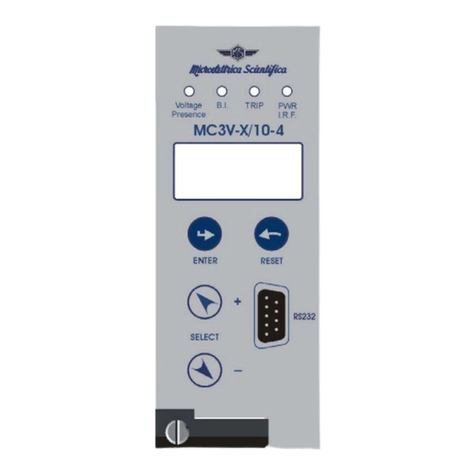
MICROENER
MICROENER MC3V-X/10-4 User manual
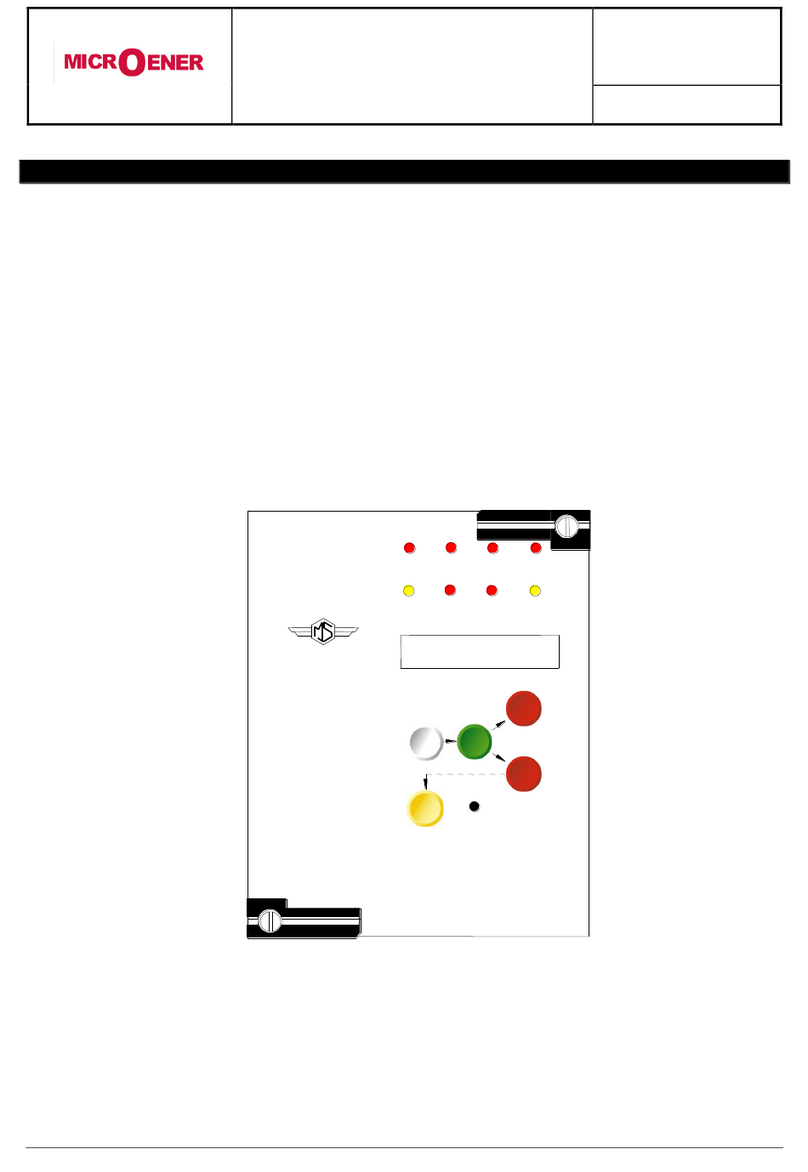
MICROENER
MICROENER M-LIB3 User manual
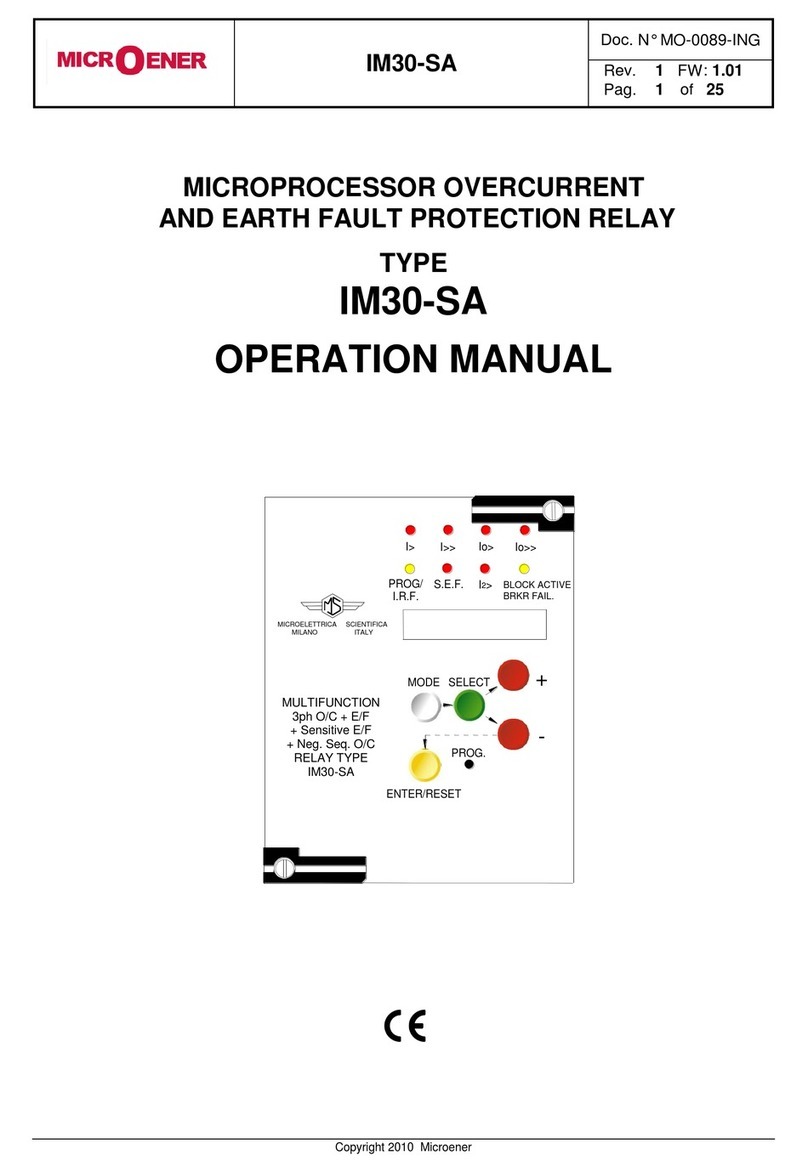
MICROENER
MICROENER IM30-SA User manual
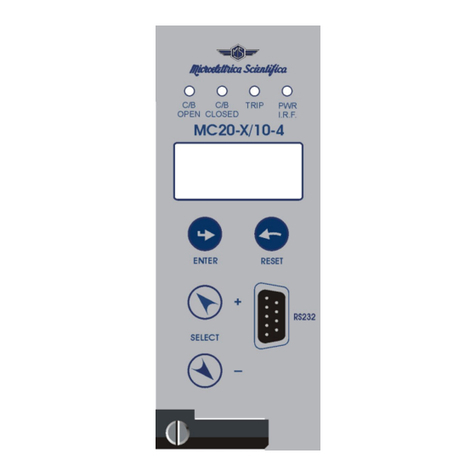
MICROENER
MICROENER MC20-X/10-4 User manual
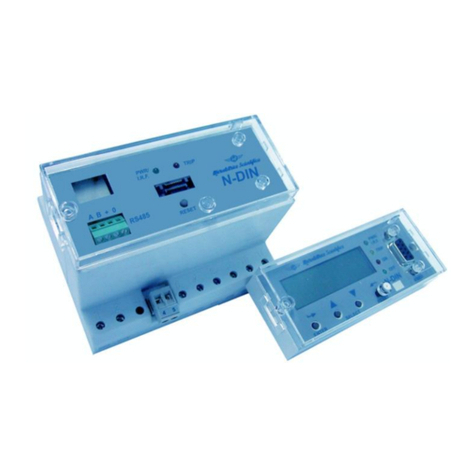
MICROENER
MICROENER N-DIN-MSG User manual
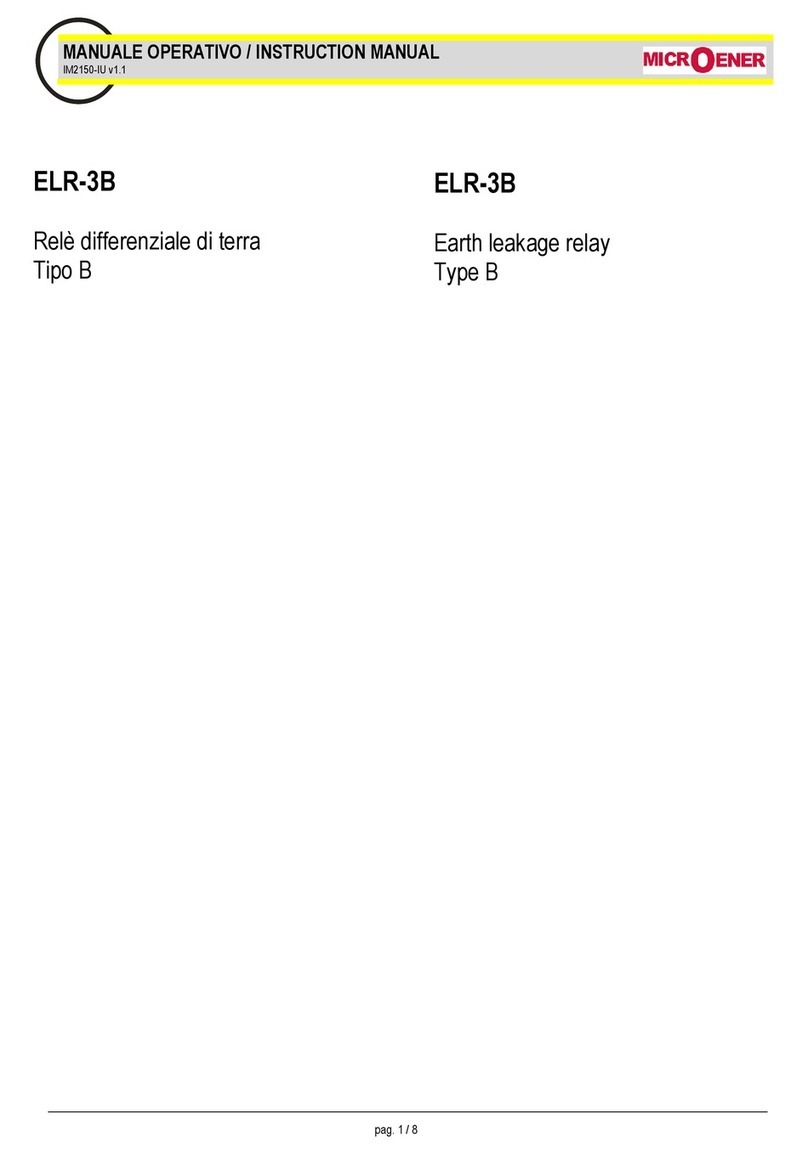
MICROENER
MICROENER ELR-3B User manual
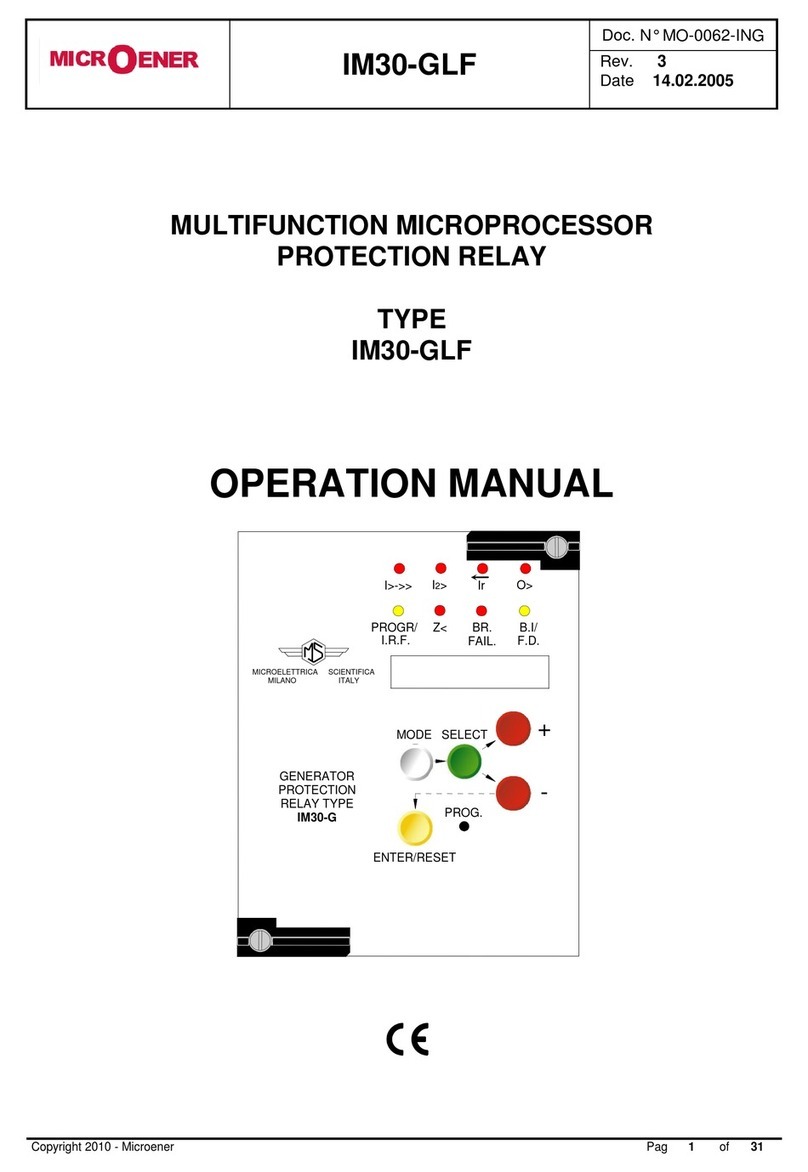
MICROENER
MICROENER IM30-GLF User manual

MICROENER
MICROENER IM30-B00 User manual
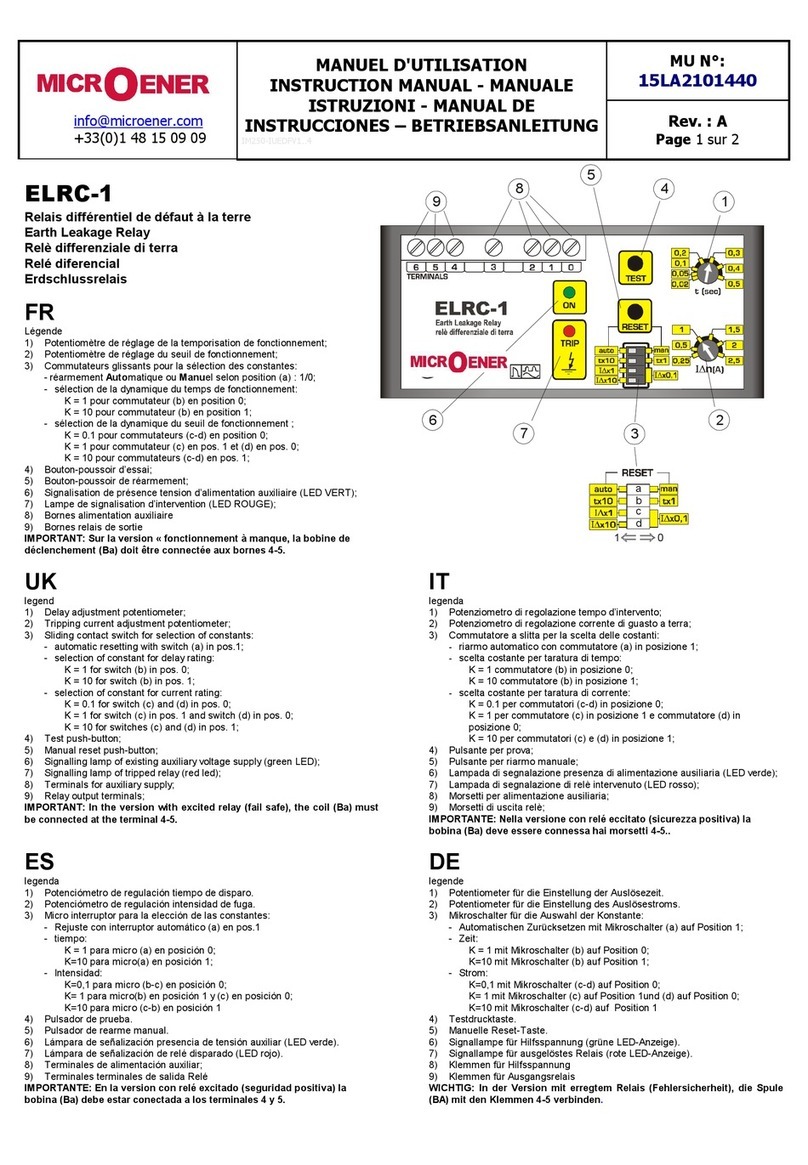
MICROENER
MICROENER ELRC-1 User manual

MICROENER
MICROENER ULTRA Series User manual


